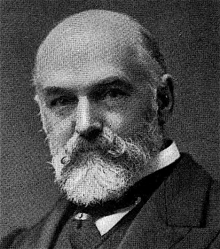
John Dibblee Crace [also known as John D. Crace] was born London, England on 19 January 1838. His father, John Gregory Crace (1809–1889), was an interior decorator; his grandfather, Frederick Crace (1779-1859) was an architect and interior decorator; and his great--great-grandfather, Edward Crace (1725–1799), founder of the Crace interior decorating business in 1743, was a coach decorator and keeper of the king's pictures.
John Dibblee Crace was articled to his grandfather in 1852. He first came to prominence in the 1860s with the work he did in assisting his father in the decoration of the exhibition building at the 1862 International Exhibition in London, followed by work in the decoration of the British contribution to the Exposition Universelle in Paris in 1867. Over the next two decades he increasingly began to take over the running of the family business.
Notable among his commissions during this period were the decoration of Knightshayes Court, near Tiverton, Devon (1874–82), which Crace completed following the dismissal of William Burges (1827-1891); the Pompeian Room at Ickworth in Suffolk (1879) decorated in collaboration with the architect Francis Penrose (1817-1903) and the French painter Henry Scholtz (1868-1904); and decoration of Longleat House, near Warminster in Wiltshire (1874-82) for the fourth marquess of Bath.
During the 1890s Crace worked extensively for William Waldorf Astor, for whom he designed elaborate interior schemes for Clivedon, his country house in Taplow, Buckinghamshire, 18 Carlton House Terrace, London, and Two Temple Place, Astor's estate office in London.
In his later years, Crace was engaged on redecoration schemes including for Leeds Town Hall (1894), originally design by his father in 1857; and for the Royal Pavilion in Brighton, Sussex (1894-98), originally designed by grandfather in 1815-22.
Crace was founder of the Institute of British Decorators and its first President from 1897 to 1917. He was elected an Honorary Associate of the Royal Institute of British Architects (Hon.ARIBA) in 1889. He was also a Fellow of the Society of Architects (FSA), a member of the Society of Arts and a member of the Architectural Association. He was elected Master of the Painter–Stainers' Company in 1884 and was presented with the Institute of British Decorators' Gold Medal in 1908. He closed his business in 1899 and subsequently devoted much of his time to writing. He was the author of The Coloured Decoration of Architecture (1900); Gleanings in the Field of Ancient Art (1907) and the Art of Colour Decoration (1913).
He died at his home, 15 Gloucester Place, London on 18 November 1919.
Aldrich, Megan. The Craces: Royal Decorators, 1768-1899. London: John Murray, 1990 [Published in conjunction with an exhibition at Brighton Royal Pavilion, Art Gallery & Museums]
Aldrich, Megan Brewster. The Crace firm of decorators, 1768 to 1899. Ph. D. thesis, University of Toronto, 1987
Directory of British Architects 1834-1914. Compiled by Antonia Brodie, et al. Volume 1: A-K. London; New York: British Architectural Library, Royal Institute of British Architects/Continuum, 2001
‘Obituary’. The Builder vol. 117, 28 November 1919 pp. 531, 534
‘Obituary’. Royal Institute of British Architects Journal vol. 37, December 1919 pp. 63-64